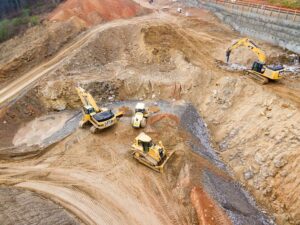Earth Works Safety Standards: Comprehensive Guide to Excavation and Civil Works Safety in the UK
Excavation and civil works demand unwavering attention to safety standards to prevent injuries, protect assets, and maintain regulatory compliance. This guide maps out critical best practices—from trench support and utility avoidance to heavy plant protocols and site management—while demonstrating how Earth Works, LLC integrates OSHA-certified training, trenching boxes, and shoring systems into every project. You will learn:
- Key excavation safeguards aligned with UK HSE and CDM Regulations 2015
- Heavy equipment operation controls and lockout/tagout procedures
- Civil works site risk assessments, PPE protocols, and emergency response planning
- Cultivating a proactive safety culture and environmental stewardship on site
What Are the Key Excavation Safety Best Practices in the UK?
Effective excavation safety combines protective systems, utility detection, and daily inspections to reduce collapse and strike risks. Earth Works, LLC’s crews—OSHA 10 certified and overseen by OSHA competent persons—employ trench boxes and shoring in trenches over 1.5 metres, while referencing HSE guidance (HSG47) for underground service avoidance.
How Do Trenching and Shoring Systems Prevent Excavation Hazards?
Trenching and shoring systems safeguard workers by supporting trench walls against soil pressure and vibrations. Trench boxes create a rigid framework that resists collapse, while timber or hydraulic shores adapt to ground conditions. These systems maintain safe excavation profiles and enable daily inspections by a competent person, reducing collapse risk.
What Are the Safe Digging Procedures to Avoid Underground Utility Strikes?
Safe digging begins with pre-excavation locates using cable avoidance tools (CAT) and ground-penetrating radar (GPR). Crews mark service runs and hand-dig within 300 mm of markings. Earth Works, LLC integrates colour-coded zone demarcation and confirms live service status before mechanical excavation, ensuring utility strike prevention.
How Is Ground Stability Assessed to Prevent Trench Collapses?
Ground stability assessments classify soil into Types A, B, and C based on cohesion and moisture. A competent person inspects trench depth, groundwater levels, and surcharge loads daily. Sloping, benching, or shielding is then selected according to soil type, trench depth, and adjacent loads to maintain sidewall integrity.
What Role Does the Competent Person Play in Excavation Safety?
A competent person—certified under OSHA and trained in HSE standards—identifies hazards, assesses soil conditions, and approves protective systems. This individual inspects trenches at the start of shifts and after any change, issues stop-work orders if necessary, and verifies that crews follow shoring, sloping, and utility-avoidance protocols.
How Does Heavy Equipment Safety Impact Earth Works Projects?
Heavy equipment safety governs productivity, incident prevention, and site flow. Proper operator certification, pre-start checks, and communication procedures ensure that excavators, dozers, and loaders operate without endangering workers or delaying schedules.
What Training and Certification Are Required for Heavy Equipment Operators?
Heavy plant operators must complete OSHA 10 training, plus manufacturer-specific courses. Earth Works, LLC requires all operators to hold proof of competence, complete on-site practical assessments, and refresh certifications annually to maintain familiarity with controls, attachments, and emergency stops.
How Are Pre-Operation Checks and Maintenance Conducted Safely?
Pre-operation inspections cover fluid levels, hydraulics, tracks, and safety devices. Operators use a standard checklist—confirming brake function, horn operation, and rollover protection—and record findings. Any defect triggers a lockout/tagout process until maintenance teams restore safe working condition.
What Communication and Signalling Practices Ensure Safe Site Vehicle Movement?
Effective signalling uses standard hand signals and two-way radios. Spotters guide blind spots and crossing paths, establishing exclusion zones around active equipment. Earth Works, LLC enforces high-visibility garments and designated communication protocols to coordinate movements and prevent collisions.
How Do Lockout/Tagout Procedures Protect Workers During Equipment Use?
Lockout/tagout isolates energy sources before maintenance or repairs. A certified technician de-energises hydraulics, electrical systems, and attachments, then applies locks and tags. Only the person who locked out the equipment may remove tags, ensuring no unexpected startups during servicing.
What Are the Essential Civil Works Site Safety Management Standards?
Civil works safety management integrates risk identification, regulatory compliance, and emergency preparedness into daily operations. Maintaining clear method statements and CDM 2015-aligned procedures drives consistent protection across all activities.
How Are Risk Assessments and Method Statements Developed for Earthworks?
Risk assessments identify hazards—such as trench collapse, vehicle strikes, and utility strikes—and evaluate likelihood and severity. Method statements then prescribe control measures, PPE requirements, and rescue plans. Documents are reviewed by Earth Works, LLC’s principal designer and updated whenever site conditions change.
How Does Compliance with CDM Regulations 2015 Enhance Site Safety?
CDM 2015 establishes duties for clients, designers, and contractors to coordinate health and safety from design through handover. By adopting CDM principles—such as appointing a principal designer and maintaining a health and safety file—teams reduce ambiguity, promote hazard elimination, and ensure documentation integrity.
CDM Regulations 2015: An Impact Analysis for UK Construction SMEs
The Construction (Design and Management) Regulations, commonly referred to as CDM Regulations, represent a fundamental initiative by the UK government aimed at managing the business activities of small, medium, and large-scale construction organisations in a coordinated, safe, and lawful manner. A significant proportion of UK construction businesses are small and medium-sized enterprises (SMEs). In 2015, the UK government introduced new policies to be enforced under the updated CDM Regulations 2015. Consequently, it is highly probable that the new instructions and guidelines within CDM 2015 will have a considerable impact on the UK construction industry, affecting the construction requirements and methodologies of other SMEs across the UK. This research was therefore undertaken to analyse the positive and negative impacts of CDM 2015 on UK construction SMEs, and to identify approaches that could be recommended for improved enforcement of the regulations and for achieving better compliance.
AN EVALUATION OF THE PERCEPTION AMONG SMES ABOUT THE IMPLICATIONS OF THE NEW CDM REGULATIONS 2015: BENEFITS AND PITFALLS, 2015
What Personal Protective Equipment (PPE) Is Required on Civil Works Sites?
PPE protocols mandate high-visibility clothing, safety helmets, steel-toe boots, gloves, and eye protection. Additional equipment—such as harnesses for working near edges or respirators in dusty conditions—aligns with risk assessments. Earth Works, LLC supplies, inspects, and replaces PPE per manufacturer guidelines.
How Are Emergency Response and First Aid Preparedness Managed?
Emergency plans designate muster points, evacuation routes, and communication trees. Trained first-aid responders are on site with stocked stations and defibrillators. Regular drills validate response times and uncover procedure gaps, maintaining readiness for medical or environmental incidents.
How Does Earth Works, LLC Promote a Proactive Safety Culture?
A proactive safety culture emphasises continuous improvement, open reporting, and shared accountability. By embedding safety as a core value, Earth Works, LLC minimises incidents and fosters workforce engagement.
What Is Earth Works, LLC’s Safety Statement and Commitment?
Earth Works, LLC’s safety statement affirms a “zero-accident” goal through rigorous compliance, ongoing training, and transparent leadership. Management pledges to allocate resources for best-in-class protective systems, regular audits, and competence development.
How Are Employee Training and Competency Ensured?
Training programmes combine OSHA 10 certification, competent person courses, and hands-on workshops. Refresher sessions and toolbox talks reinforce standards, while competency assessments confirm understanding of excavation, plant operation, and emergency procedures.
What Processes Are Used for Safety Audits and Continuous Improvement?
Monthly safety audits review equipment logs, incident reports, and compliance checklists. Findings feed into corrective action plans, which assign responsibilities, deadlines, and follow-up inspections to verify closure of non-conformities.
How Is a Proactive Safety Culture Fostered on Site?
Site teams conduct daily safety briefings, encouraging crew members to raise concerns without reprisal. Incentive programmes recognise safe behaviours and near-miss reporting, turning lessons learned into shared improvements and reinforcing team ownership of safety outcomes.
What Environmental Safety Measures Are Critical in Earthworks?
Environmental safety ensures soil stability, pollution control, and sustainable waste management. Integrating erosion prevention and dust suppression maintains community relations and regulatory compliance.
How Is Soil Management and Erosion Control Implemented?
Silt fences, sediment basins, and geotextiles contain run-off on disturbed areas. Soil compaction assessments guide slope gradients to prevent slips, while staged excavation limits exposed soil, reducing erosion during heavy rainfall.
What Pollution Prevention Practices Are Used for Water, Noise, and Dust?
Water retention ponds and spill kits prevent contaminant run-off. Acoustic barriers and mufflers mitigate noise, and water-spray suppression controls dust. Equipment maintenance reduces emissions, aligning with environmental permits and local bylaws.
How Is Waste Managed and Recycling Promoted on Construction Sites?
Segregated waste streams and on-site skips facilitate recycling of metal, concrete, and timber. Earth Works, LLC partners with licensed recyclers, tracks waste volumes, and aims for landfill diversion rates above 75 percent to minimise environmental impact.
Excavation & Civil Works Safety Standards: UK Best Practices
Identifying hazard trends drives targeted controls for trench collapse, utility strikes, and heavy machinery incidents. Mitigation combines engineering solutions, training, and procedural enforcement.
What Are the Main Causes of Trench Collapses and How Can They Be Prevented?
Trench collapses stem from unstable soil, water infiltration, and surcharge loads. Preventive measures include daily competent-person inspections, installation of shoring or sloped sidewalls, and controlling adjacent traffic or stockpiles.
How Are Underground Utilities Safely Located and Avoided?
Utility strikes occur when service maps are outdated or markings are ignored. Cable avoidance tools (CAT) and GPR surveys validate plans. Pre-dig hand-excavation around marked lines ensures safe clearance before machine use.
What Are the Risks Associated with Heavy Machinery and How Are They Minimized?
Machine rollovers, blind-spot collisions, and unexpected startups pose major risks. Operator training, spotter communication, active lockout/tagout, and routine maintenance inspections minimise these dangers, ensuring controlled use and safe equipment condition.
What Are the Frequently Asked Questions About Earth Works Safety Standards?
Key queries often focus on core safety rules, trenching regulations, oversight roles, and emergency protocols. Understanding these essentials supports compliance and consistent site performance.
What Are the 5 Main Safety Rules in Construction?
The five essential rules are conducting thorough risk assessments, implementing protective measures (shoring, sloping), enforcing PPE use, ensuring equipment safety checks, and maintaining clear emergency response plans.
What Is the 1.2 Metres Rule for Trenching?
The 1.2 metres rule mandates that trenches deeper than this require protective systems—such as trench boxes or shoring—and daily inspection by a competent person before worker entry.
Who Oversees Worker Safety in Excavation Sites?
A site manager and a designated competent person share oversight duties, with the competent person inspecting trenches, verifying protective systems, and authorising safe work practices under OSHA and HSE guidance.
What Are the Essential PPE Requirements for Earthworks?
Essential PPE includes high-visibility clothing, hard hats, steel-toe boots, gloves, eye protection, and, where necessary, respiratory or fall-arrest equipment—selected according to the site’s risk assessment.
How Are Emergency Preparedness and Incident Response Managed?
Emergency preparedness involves documented evacuation routes, trained first-aid responders, communication trees, and regular drills. Incident response protocols emphasise rapid medical aid, root-cause analysis, and corrective action to prevent recurrence.
Earth Works, LLC’s unwavering commitment to safety—from excavation best practices and heavy plant controls to environmental stewardship and proactive culture—ensures projects proceed efficiently and incident-free. By aligning OSHA-certified training with UK HSE and CDM 2015 best practices, every site benefits from rigorous risk management, compliant procedures, and continuous improvement. Consistent audits, clear communication, and dedicated competent persons guarantee that safety remains the foundational pillar of every civil works endeavour.


